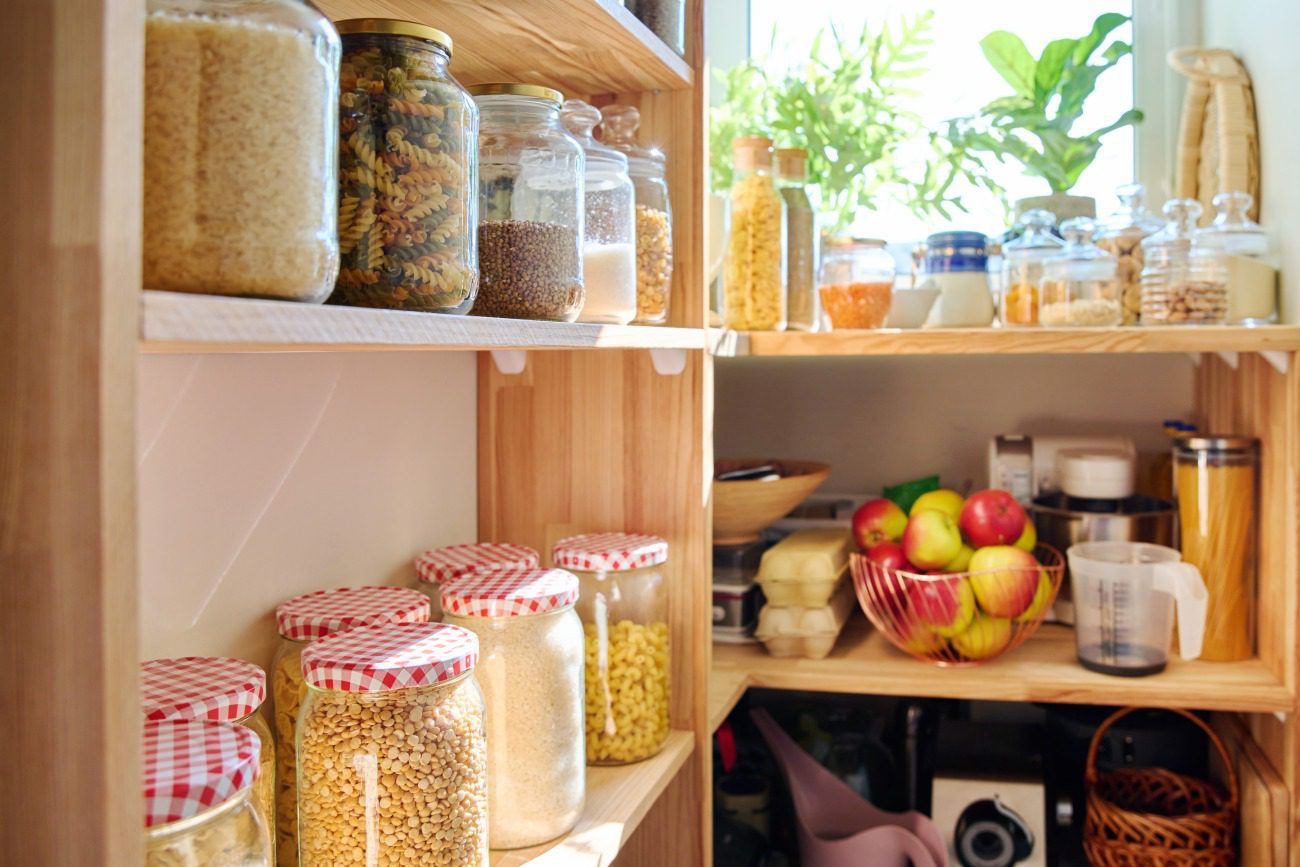
[ad_1]
The pantry is an excellent place to store kitchen staples, but there are bound to be some that spoil faster than you think or should never have been there in the first place. A pantry is a difficult space to keep organized. If your kitchen pantry is like most people’s, it becomes a catch-all for a wide range of food items.
Even in the most meticulously organized pantry, it can be difficult to tell which foods are new and which have been around for longer than they should. Many commonly stored pantry items will expire, spoil, or become contaminated over time.
Some are just taking up valuable space that you could fill with items you use on a regular basis. A clear understanding of which foods should be removed from your pantry will ensure that it is stocked with fresh and safe food items, transforming your kitchen into a source of healthful and delicious meals.
Items to Purge From Your Pantry

Several pantry items have relatively short expiration dates because of their ingredients, packaging, or susceptibility to spoilage. Other food items that you will almost certainly never use are taking up space in your pantry, preventing streamlined and efficient organization. Regularly purging these expired or unnecessary items will result in a more spacious and clean pantry.
1. Whole Grain Flours
Whole grain flours must be stored properly in order to maintain their nutritional freshness and value, as the natural oils can quickly turn rancid if not kept in optimal conditions. Unlike refined flours, whole grain varieties contain the bran and germ from the wheat, which spoil more quickly. This includes whole grain flours like wheat, rye, and spelt. According to most experts, whole grain flours last about three months at room temperature.
To extend their shelf life at room temperature, store them in an airtight container in a cool, dry area of your pantry. For even longer storage, place them in the refrigerator or freezer because the cold temperatures slow the oxidation that causes them to go rancid. Cold storage will extend the shelf life of whole grain flours to 6-9 months. Always keep them in an airtight container to avoid moisture and pests.
2. Nuts
Nuts spoil quickly due to their high oil content, which makes them susceptible to oxidation and rancidification. When nuts are exposed to light, their oils are broken down, resulting in off flavors and odors that indicate that they have spoiled. This process is accelerated in hot, humid, and bright environments, particularly during the summer months, when these conditions are most prevalent. Nuts can also absorb the odors of surrounding foods, which also impacts their flavor,
To extend their shelf life, it is vital that nuts be stored in a cool, dark, and dry environment in an airtight container. For an even longer shelf life, refrigerating or freezing the nuts will best preserve their integrity, ensuring that they are fresh and flavorful for a longer period of time.

3. Certain Oils
Certain oils, due to their chemical composition, particularly their levels of unsaturated fat, will go rancid sooner than others. This includes nut and seed oils such as walnut, flaxseed, sesame, grapeseed, and hemp. These oils contain a high percentage of unsaturated or polyundaturated fats, which are less stable and more sensitive to light, heat, and air. When these oils go rancid, they lose flavor, vitamins, and may develop potentially toxic compounds.
Keeping these oils in dark glass containers and in a cool, dark place will help them last longer. Some experts recommend storing them in the refrigerator. This can cause a cloudy appearance, which, while not harmful to taste or health, can be unappealing to consumers.
4. Spices and Herbs
Storing spices and herbs is critical for maintaining their potency, flavor, and aroma over time. Spices and herbs are sensitive to light, heat, moisture, and air, all of which can reduce their quality quickly. It is also necessary to keep track of when you buy your spices because, even with the best storage, bottled herbs and spices will lose their effectiveness. The specific length of time you can keep herbs and spices depends on the specific variety, but most spices remain potent up to two years and herbs range between 1-3 years.
To maximize their shelf life, store them in a cool, dry place in an air-tight container. This helps to protect their volatile oils that give them their characteristic flavor. Whole spices tend to hold their flavor longer than ground varieties. Regularly checking the flavor of your herbs and spices will ensure that they remain effective and vibrant for your cooking.
5. Baking Products
Baking powder, soda, yeast, sugars, and chocolate are all sensitive to heat, light, and air. Baking powder, soda, and yeast contain ingredients that degrade and lose their effectiveness when exposed to these environmental factors. This means that your baked goods will be flat and dense, rather than soft and filled with air pockets. Sugar can become dense and hard when exposed to humidity, while chocolate develops a white, powdery surface.
These items should always be stored in airtight containers in a cool, dry area of the pantry. Baking soda and yeast can be kept fresher for longer by storing them in the fridge or freezer.
6. Dry Grains and Pasta
Dry grains and pastas are considered shelf stable because they maintain their structural and flavor integrity while in the pantry. However, even these items can deteriorate over time due to exposure to moisture, air, and pests as a result of improper storage. This is especially true for whole grains and whole grain pasta, such as quinoa, farro, brown rice, and whole wheat pasta.
Store these items in airtight containers in a cool and dry place to preserve their freshness and flavor. Label these items with purchase dates so that you can always use older items before buying new ones.
7. Exotic Food Gifts and Souveniers
Almost everyone has some exotic food gifts and souvenirs in their pantry that take up valuable pantry space. These items frequently accumulate in the pantry because they are not part of your regular cooking routine. People often feel guilty about getting rid of these items because they believe they will eventually use them, or they feel bad about discarding a gift. But many of these items contain delicate ingredients such as oil, herbs, and spices, which will eventually go bad.
Consider which exotic food items you will actually use and which you will not. Discard the items that are just taking up space, and keep the ones that are important to you. If you want to use a specific item, devise a concrete plan for incorporating it into future snacks and meals.

8. Condiments
Many condiments are purchased for one specific recipe and then relegated to the back of the pantry and forgotten. Items like sauces, spreads, and dressings need to be checked periodically to ensure that they are still flavorful and haven’t spoiled.
Check the expiration dates regularly. Assess which condiments you use on a regular basis and those that you might never use again. Try to avoid duplicate items by keeping all of your condiments in the same place and checking them before you purchase other condiments.
9. Dried Fruit
Dried fruit, while shelf stable and convenient, can often degrade more quickly than you use it, especially if the dried fruit does not contain preservatives. Dried fruit can develop mold in humid environments or if exposed to moisture. Dried fruit can also lose its flavor and become dry and leathery.
Examine the condition of dried fruits like raisins, cranberries, and apples. Discard any fruit that shows signs of deterioration or mold. To extend the shelf life of your dried fruit, store it in a cool, dry location in an airtight container.
How Do I Know When My Pantry Items Have Gone Bad?
Knowing when pantry items have gone bad involves regularly monitoring your items and using your senses to observe changes in appearance, taste, texture, and smell.
- Check for Expiration Dates: One of the simplest ways to tell if your pantry items have gone bad is to look for expiration or “best-used by” dates on the packaging. While these are typically conservative estimates, they can also be used to determine when a food item is no longer good.
- Inspect Packaging: Look for signs of damage to the packaging, such as bulges, leaks, and tears. This will accelerate the deterioration of the interior contents compared to intact packaging.
- Use Your Senses: Smell the items in question to see if you detect a sour or rancid odor, which may indicate spoilage. Look for changes in the items’ appearance, such as discoloration, mold, or unusual spots. Feel the item to check for clumping, hardness, or unusual stickiness.
- Look for Indications of Pests: Check for signs of pests, such as insects, rodents, or their droppings.
- Test Effectiveness: Certain items like baking powder, soda, and yeast will fizz or bubble in hot water if still active.
- Trust Your Judgement: After you have assessed the item using the steps outlined above, you can decide based on the steps above whether it is still good. If you are unsure, it is always better to discard rather than use the item in question.
[ad_2]
Source link





